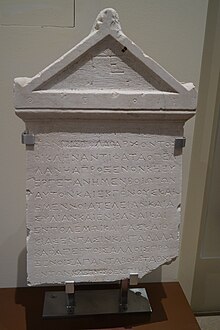Onchestos (city)
Onchestos ( Greek Ογχηστός ) was an ancient Greek city in Boeotia . It was located on the Steni Pass about 3 km southwest of the Sphinx mountain on the southern edge of the Kopaïs . It was in the area of Haliartus and was also under his protection.
Lore
The mythical hero Onchestus is considered the founder of the city . Boiotos founded the famous sanctuary of Poseidon in Onchestos. Megareus of Onchestos supported Nisos in the fight against Minos when he had invaded the Megaris . However, Megareus fell in battle and was buried on the spot. Megara , which was previously called Nisai, is said to have been named after him. In the ship catalog of the Iliad Onchestus is listed among the contingents of the Boeotians. Homer reports that the sanctuary of Poseidon had a sacred grove. Strabo doubts the existence of this grove. He also criticizes Alcaios of Lesbos , who claimed that Onchestus was at the foot of the Helicon . However, the city is further away from this mountain and is located on the hill that separates the Tenerife fields from the Kopaïs.
The Amphictyon Council of the Boeotian League met in Onchestus . 480 BC Onchestus was burned to the ground by Xerxes I during the Second Persian War . 171 BC It was probably destroyed by the Romans at the same time as Haliartus.
description
The exact extent of the city is not known. The foundations of the Temple of Poseidon ("Site A") were found at the highest point of the Steni Pass, directly south of the road from Thebes to Aliartos . Poseidon was revered here as the inventor of the chariot . Even in Homeric times, Minyans from Orchomenos and Thebans are said to have organized chariot races here in honor of the god. The hero Heracles , nicknamed Hippodetes, was also sacrificed here. Right next to it, a building was found that is believed to have been the Buleuterion . The remains of the agora ("Site B") were probably found about 700 m north-west of the temple . By means of geomagnetic mapping it could be established that the agora was related to the temple. A round building with a diameter of around 40 m was also found. The function of this building is unclear as no comparable building is known to date. The acropolis was about 300 m south of the sanctuary of Poseidon.
exploration
The first test excavations were carried out in 1964 by the archaeologist Eve Touloupa. In 1971 Theodoros Spyropoulos uncovered part of the temple and bouleuterion. Fanouria Dakoronia carried out the first systematic excavations and discovered a 48 m long building from 1973-74. In 1991 Alexandra Christopoulou discovered a long building with 18 or 19 rooms. This is probably a stoa . Ioannis Mylonopoulos has been leading the excavations in Onchestos since 2014 .
history
The oldest finds in Onchestos date from the Bronze Age (around 3000–1000 BC). The temple and its outbuildings were built in the Archaic Period (late 6th to early 5th century BC). Most of the pottery shards come from the classical period . At least since the Hellenistic period (end of the 4th century BC) Onchestos has been the seat of the amphictyony. 171 BC BC it was destroyed by the Romans. When Pausanias visited Onchestus in the 2nd century AD, he found it abandoned. However, he reports that the temple with the cult image and the sacred grove were still there.
Web links
Website of the archaeological excavation in Onchestos: http://onchestos.mcah.columbia.edu/
- Dominique Schaub: Onchestos ( online at yumpu.com )
- Paris Varvaroussis: Charioteers in the sanctuary of Poseidon at Onchestos ( online at archeology.wiki )
- Information on the geophysical surveys (PDF, English)
literature
- William Smith : Onchestus. In: Dictionary of Greek and Roman Geography. 1854 ( online )
- Marion Holland McAllister: Onchestus . In: Richard Stillwell et al. a. (Ed.): The Princeton Encyclopedia of Classical Sites. Princeton University Press, Princeton NJ 1976, ISBN 0-691-03542-3 .
- Anthony M. Snodgrass : An Archeology of Greece , University of California Press, Berkeley 1987, pp. 119–121 ( online )
Individual evidence
- ^ Pausanias , Travels in Greece 9.26.5.
- ^ Karl Tümpel : Boiotos 3 . In: Paulys Realencyclopadie der classischen Antiquity Science (RE). Volume III, 1, Stuttgart 1897, Col. 664.
- ^ Pausanias , Travels in Greece 1,39,5.
- ↑ Homer, Iliad 2,506.
- ↑ Strabo, Geographica 9,2,33 (p. 412).
- ↑ Ancient City Onchestos at ancientcity.ims.forth.gr
Coordinates: 38 ° 21 '33 " N , 23 ° 8' 40" E
